 |
|||||||||||||||||||||||||||||||||||||||||||
|
“ . . . you should know the places in winter
as well as in tempting summer, when song and shade and colour attract every one to the field.” |
|||||||||||||||||||||||||||||||||||||||||||
|
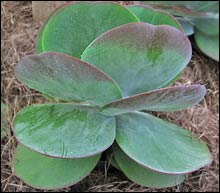 The doubled-flowered ‘Calandiva Pink’ kalanchoes that were thriving in the planters in the entry hall of this botanical garden are gone. After seeing them here I bought one – a pink one just like the ones I saw here. The large nursery and greenhouse I where I bought mine had dozens of them for sale – pinks, purples, reds, and oranges. While my Calandiva continues blooming in a south window, all the ones in the botanical garden have been replaced by another set of kalanchoes aptly named ‘Flapjack’ (Kalanchoe Thyrsiflora). Their meaty, flat leaves are spread open like a hand of cards. Each of the leaves has a ruby edging on the top side and a reddish blush underneath. None are blooming so I guess leaf shape and coloring is the draw. The doubled-flowered ‘Calandiva Pink’ kalanchoes that were thriving in the planters in the entry hall of this botanical garden are gone. After seeing them here I bought one – a pink one just like the ones I saw here. The large nursery and greenhouse I where I bought mine had dozens of them for sale – pinks, purples, reds, and oranges. While my Calandiva continues blooming in a south window, all the ones in the botanical garden have been replaced by another set of kalanchoes aptly named ‘Flapjack’ (Kalanchoe Thyrsiflora). Their meaty, flat leaves are spread open like a hand of cards. Each of the leaves has a ruby edging on the top side and a reddish blush underneath. None are blooming so I guess leaf shape and coloring is the draw.Scotch pines get a lot of attention around Christmas time. Tree growers say the tree is a holiday favorite because it has long dark-green needles, a good piney smell, stiff braches that are perfect for holding up heavy ornaments, and long-lasting needles that don’t shed during shipping, display, or aging. The one knock on the Scotch pine is its sharp needles. “You'll want to wear gloves when decorating a Scotch Pine,” tree trimming experts say. 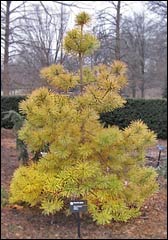 This morning I saw a Scotch pine (Pinus sylvestris) that didn’t fit the mold of the Christmas tree Scotch pines. This one was bright yellow – just about the same hue as a ginko or a larch in the fall. It’s a variety named 'Aurea.' This variety of Scotch Pine I learned on a University of Connecticut website turns yellow in the winter and then back to green when the weather warms. A hard one to miss in winter and an easy one ignore for the rest of the year. This morning I saw a Scotch pine (Pinus sylvestris) that didn’t fit the mold of the Christmas tree Scotch pines. This one was bright yellow – just about the same hue as a ginko or a larch in the fall. It’s a variety named 'Aurea.' This variety of Scotch Pine I learned on a University of Connecticut website turns yellow in the winter and then back to green when the weather warms. A hard one to miss in winter and an easy one ignore for the rest of the year.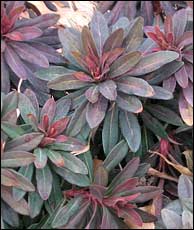 By mid-February winter has done its worst to most perennials. Even those that manage to keep their foliage look shop-worn by now. I like to look for survivors. I found one hold-out this year. It’s a spurge named ‘Efanthia.’ Its whorls of burgundy leaves have neither drooped nor browned. Even better, each stock is topped with a sprig of reddish leaves that mimic a burst of new growth. ‘Efanthia’ was developed by Proven Winners, an international cooperative of growers that develops, tests, propagates, and markets new hybrids that have unusual colors or foliage. They say that Efanthia is hardy down to -20ºF, but they don’t mention that it looks pretty spry on the way down. By mid-February winter has done its worst to most perennials. Even those that manage to keep their foliage look shop-worn by now. I like to look for survivors. I found one hold-out this year. It’s a spurge named ‘Efanthia.’ Its whorls of burgundy leaves have neither drooped nor browned. Even better, each stock is topped with a sprig of reddish leaves that mimic a burst of new growth. ‘Efanthia’ was developed by Proven Winners, an international cooperative of growers that develops, tests, propagates, and markets new hybrids that have unusual colors or foliage. They say that Efanthia is hardy down to -20ºF, but they don’t mention that it looks pretty spry on the way down. I stopped in again to see the orchid show. I lingered in the exhibit hall to see which orchid visitors would photograph most often. This morning they choose Vanda Sansai Blue ‘Meechai.’ I waited for an opening and took a picture of it too. I stopped in again to see the orchid show. I lingered in the exhibit hall to see which orchid visitors would photograph most often. This morning they choose Vanda Sansai Blue ‘Meechai.’ I waited for an opening and took a picture of it too.The six-inch snow cover is gone. The moisture from the melting snow and the downpours that followed encouraged some of the spring bulbs to break ground. I saw a few pale salmon-colored pips of early tulips coming up in one of the display gardens. In another, the distinctive vase-like prongs of hyacinths were above ground. Most common through were the daffodil spikes. Some were already about four inches tall. 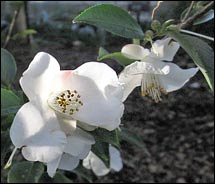 Finally. The Camellia transnokoensis is in full bloom. It’s had swelling buds since mid-November, but hasn’t done much more than look expectant. Each of its pure white blooms are small – about an inch across - but the shrub-sized plant is covered with flowers. Still, had the little camellia bloomed earlier it would have been a standout. But by waiting so long, it’s likely to go unnoticed now that all of the full-sized Camellia japonica trees are brimming with fist-sized luxuriant blooms.
Finally. The Camellia transnokoensis is in full bloom. It’s had swelling buds since mid-November, but hasn’t done much more than look expectant. Each of its pure white blooms are small – about an inch across - but the shrub-sized plant is covered with flowers. Still, had the little camellia bloomed earlier it would have been a standout. But by waiting so long, it’s likely to go unnoticed now that all of the full-sized Camellia japonica trees are brimming with fist-sized luxuriant blooms.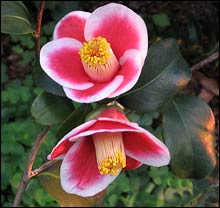 My favorite camellia this year is blooming on small plant that I think was added to this botanical garden’s collection last fall. The camellia is a japonica named ‘Tama-No-ura.’ Flowers are a couple of inches across. The petals: cherry red that bleed to a pure white uneven border. The shrub growing here is just about a yard high this year and has just three blooms, but it ought to be a real looker in a couple of years. My favorite camellia this year is blooming on small plant that I think was added to this botanical garden’s collection last fall. The camellia is a japonica named ‘Tama-No-ura.’ Flowers are a couple of inches across. The petals: cherry red that bleed to a pure white uneven border. The shrub growing here is just about a yard high this year and has just three blooms, but it ought to be a real looker in a couple of years.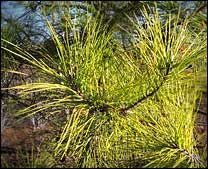 Last fall I took a guided tour of the part of the botanical garden that features native trees, plants, and flowers. On the tour, the guide pointed out what he said was the only species of pine native to Missouri -- the shortleaf Pine (Pinus echinata). He explained that the yellow-needled specimen growing here was short and scrubby-looking because as a specie, the trees are far more comfortable growing in the Ozark mountain and plateau areas south of here. A sign near the shortleaf pine says that forests of shortleaf pines and oaks once covered 6.6 million acres of the state. By my calculations, that’s about a third of all the land in the Missouri Ozarks. Right now, these shortleaf pines cover only a half-million acres. Most of them were cut down between 1880 and 1910 for lumber, railroad ties, charcoal, barrel staves, and flooring. I remember that the 1920’s bungalow we once owned had floors made “yellow wood pine” -- lumber that I’d bet was harvested from those Ozark forests of shortleaf pines.
Last fall I took a guided tour of the part of the botanical garden that features native trees, plants, and flowers. On the tour, the guide pointed out what he said was the only species of pine native to Missouri -- the shortleaf Pine (Pinus echinata). He explained that the yellow-needled specimen growing here was short and scrubby-looking because as a specie, the trees are far more comfortable growing in the Ozark mountain and plateau areas south of here. A sign near the shortleaf pine says that forests of shortleaf pines and oaks once covered 6.6 million acres of the state. By my calculations, that’s about a third of all the land in the Missouri Ozarks. Right now, these shortleaf pines cover only a half-million acres. Most of them were cut down between 1880 and 1910 for lumber, railroad ties, charcoal, barrel staves, and flooring. I remember that the 1920’s bungalow we once owned had floors made “yellow wood pine” -- lumber that I’d bet was harvested from those Ozark forests of shortleaf pines.After the shortleaf pines were cut, forests of oaks began to appear on the land. According to the Missouri Department of Conservation shortleaf pines need bare soil to germinate and lots of light, space, and nutrients to thrive. They tolerate fire well and depend upon periodic burnings to kill off the competition and to clear the undergrowth. Fire suppression policies coupled with the value of hardwoods means that shortleaf pines will probably never get a foothold in the Ozarks again. 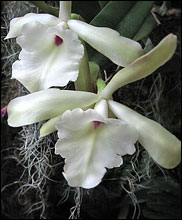 Back indoors, the botanical garden’s annual orchid show has opened. The show features about 800 of this botanical garden’s collection of 8,000 plants. The orchids are scattered in a naturalistic looking setting that has visitors looking up, down, and at eye-level. Some of the orchids are close enough to the pathways to give even those of us with cheap digital cameras a chance to get close-up pictures.
Back indoors, the botanical garden’s annual orchid show has opened. The show features about 800 of this botanical garden’s collection of 8,000 plants. The orchids are scattered in a naturalistic looking setting that has visitors looking up, down, and at eye-level. Some of the orchids are close enough to the pathways to give even those of us with cheap digital cameras a chance to get close-up pictures.The orchid display seems meant more to dazzle than inform. Apart from a label that identifies each orchid, there nothing to point visitors to the “rare and unusual plants” that garden says it has in its collection. Even so, there’s joy here. The exotic beauty of the shapes, colors, and sizes of these flowers blooming in the middle of winter will bring me back week after week even though I have meaning to stick on the splendor. |
||||||||||||||||||||||||||||||||||||||||||